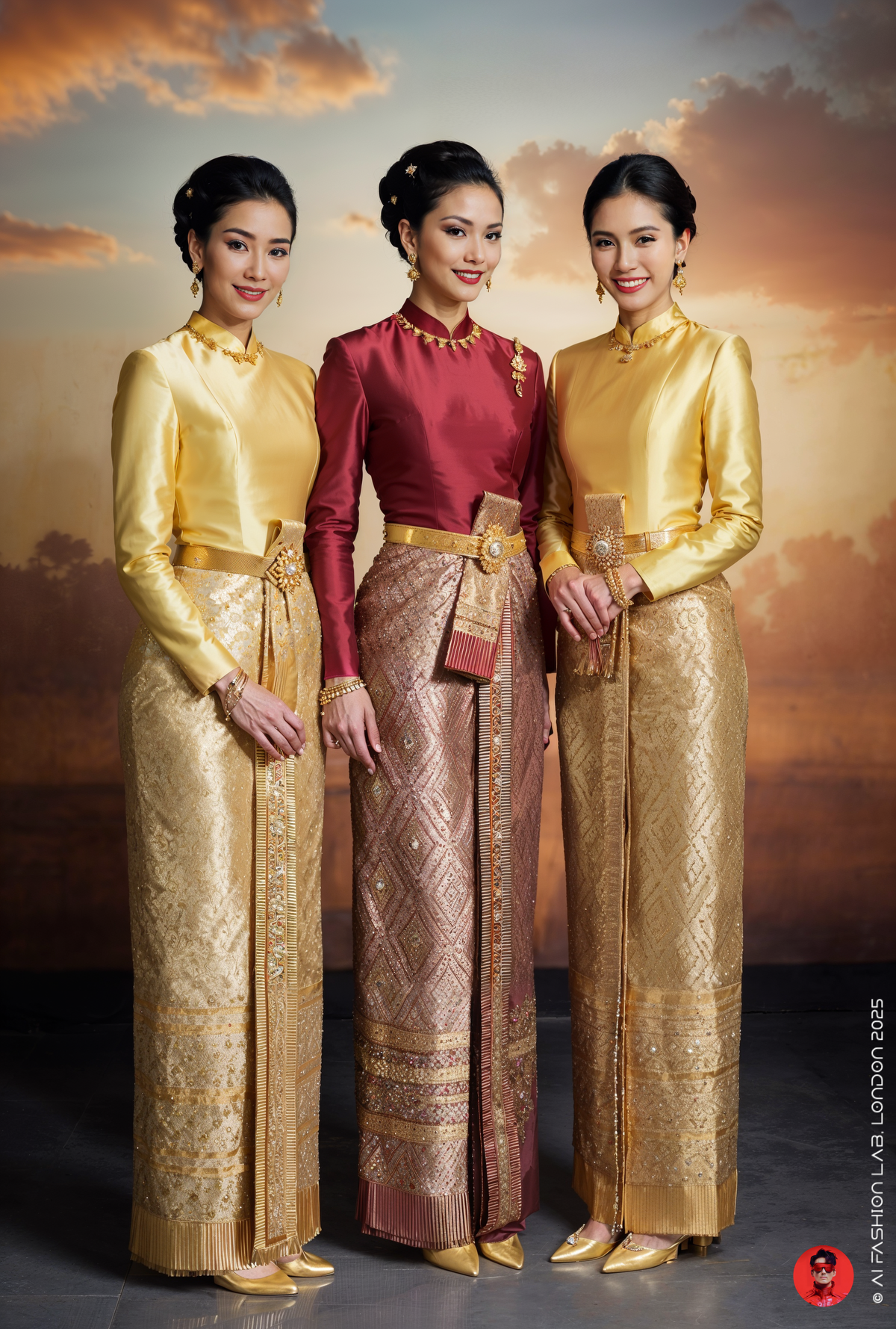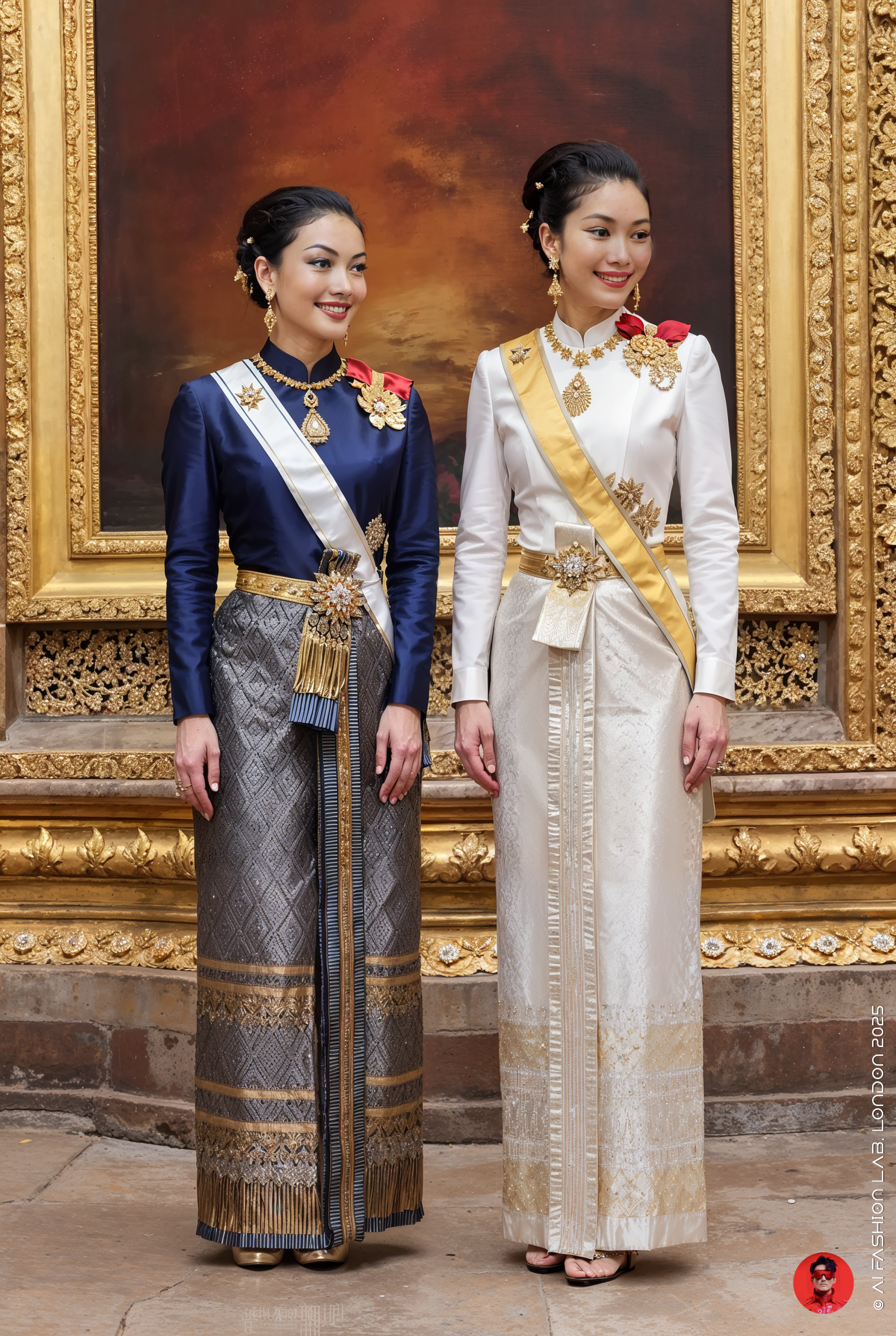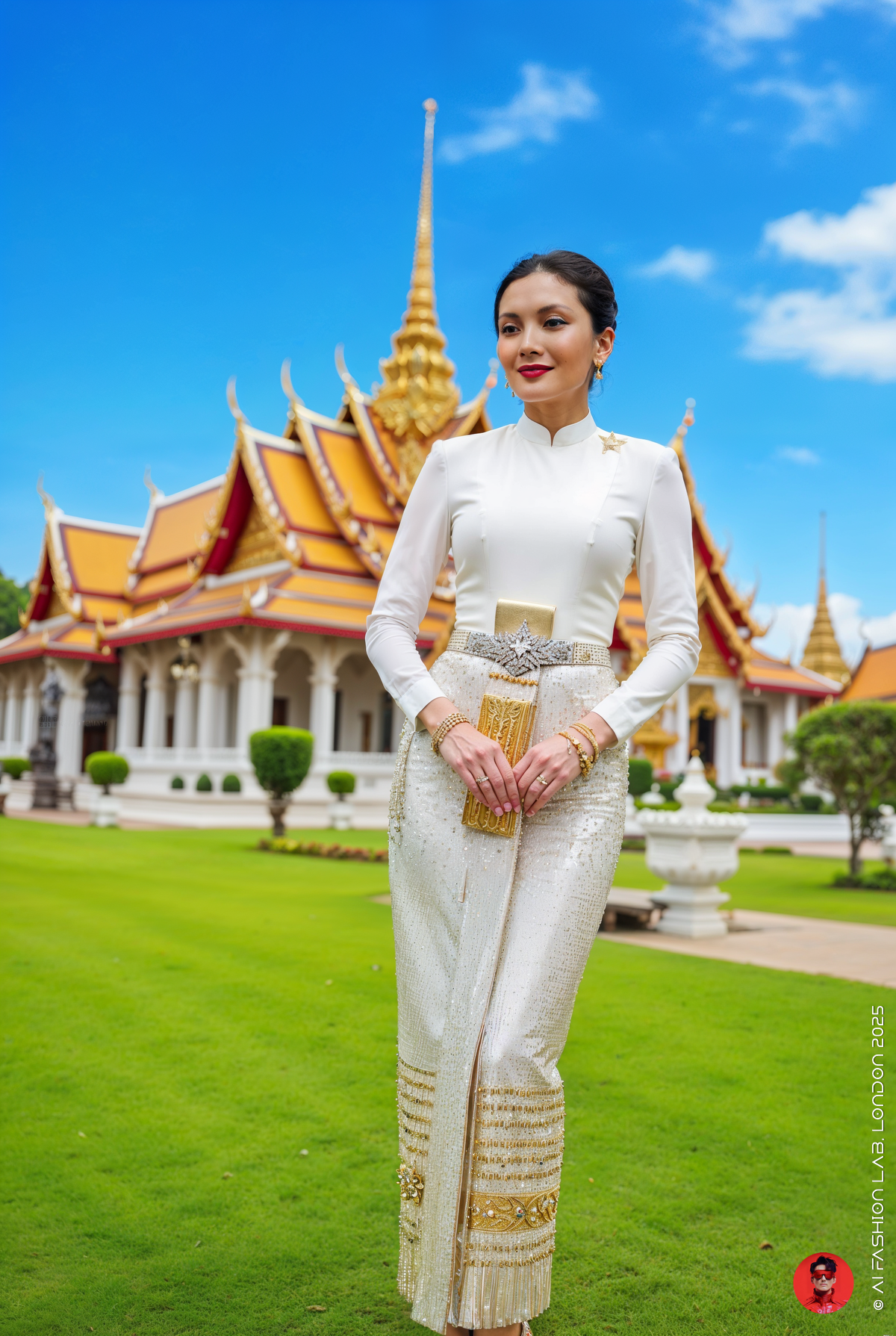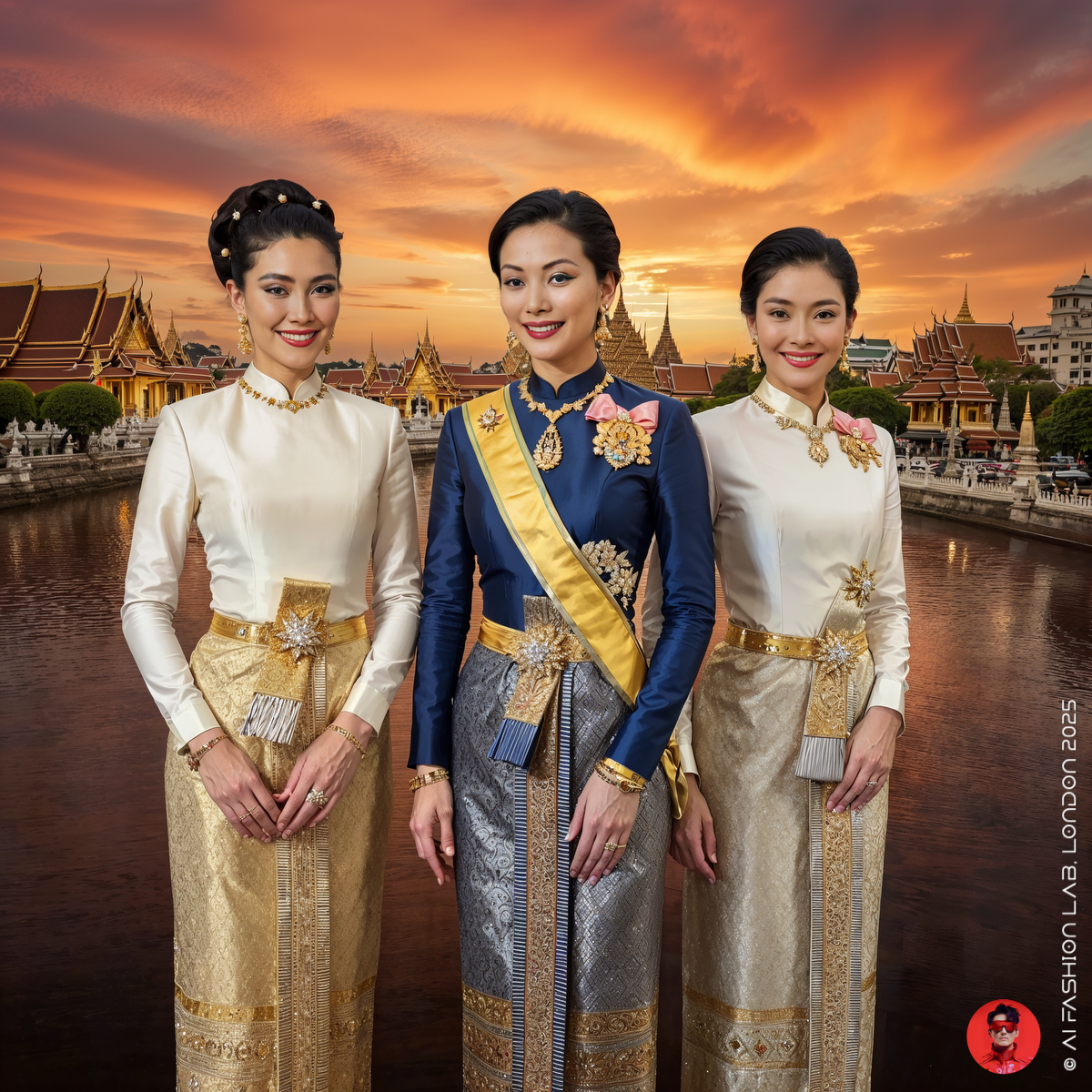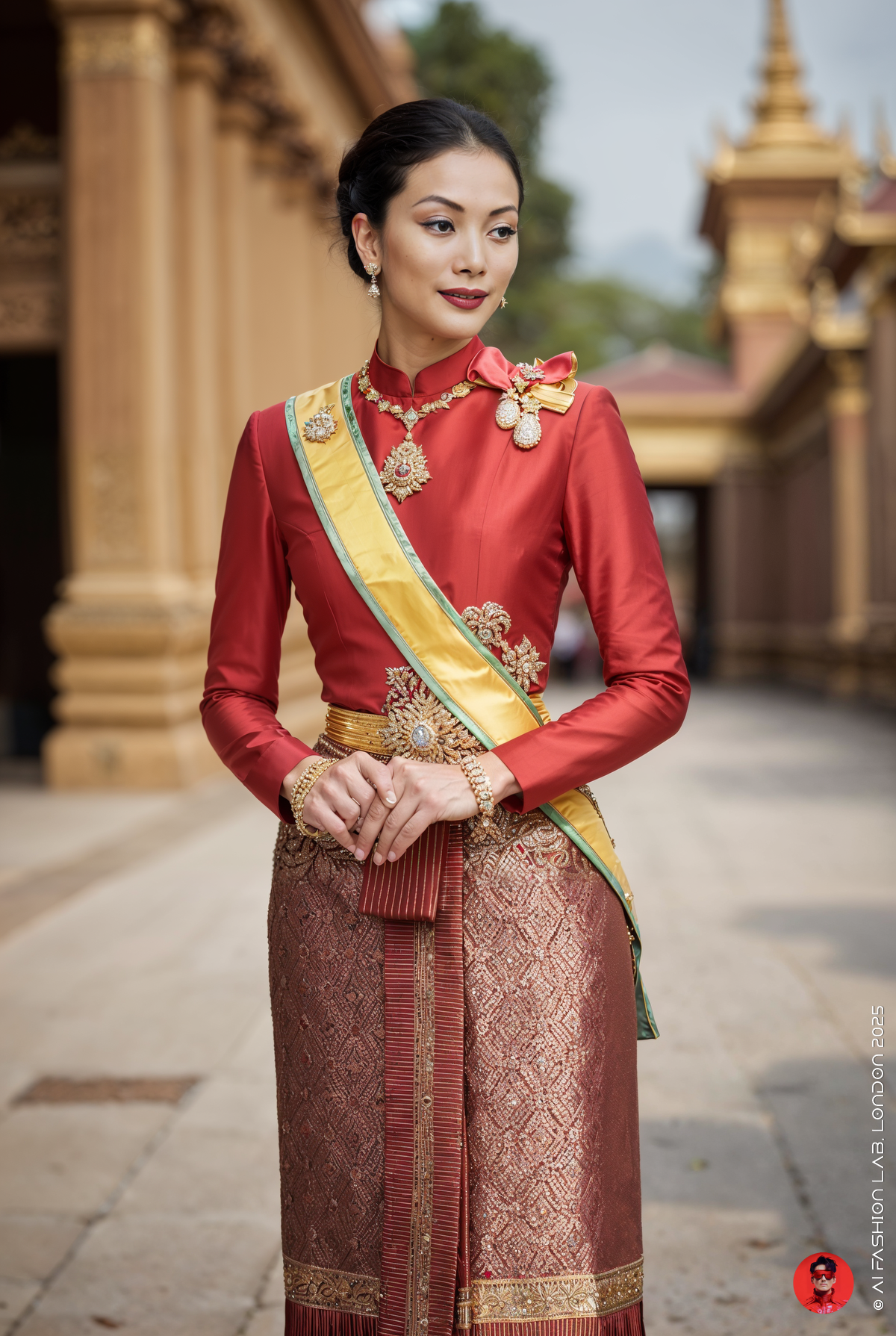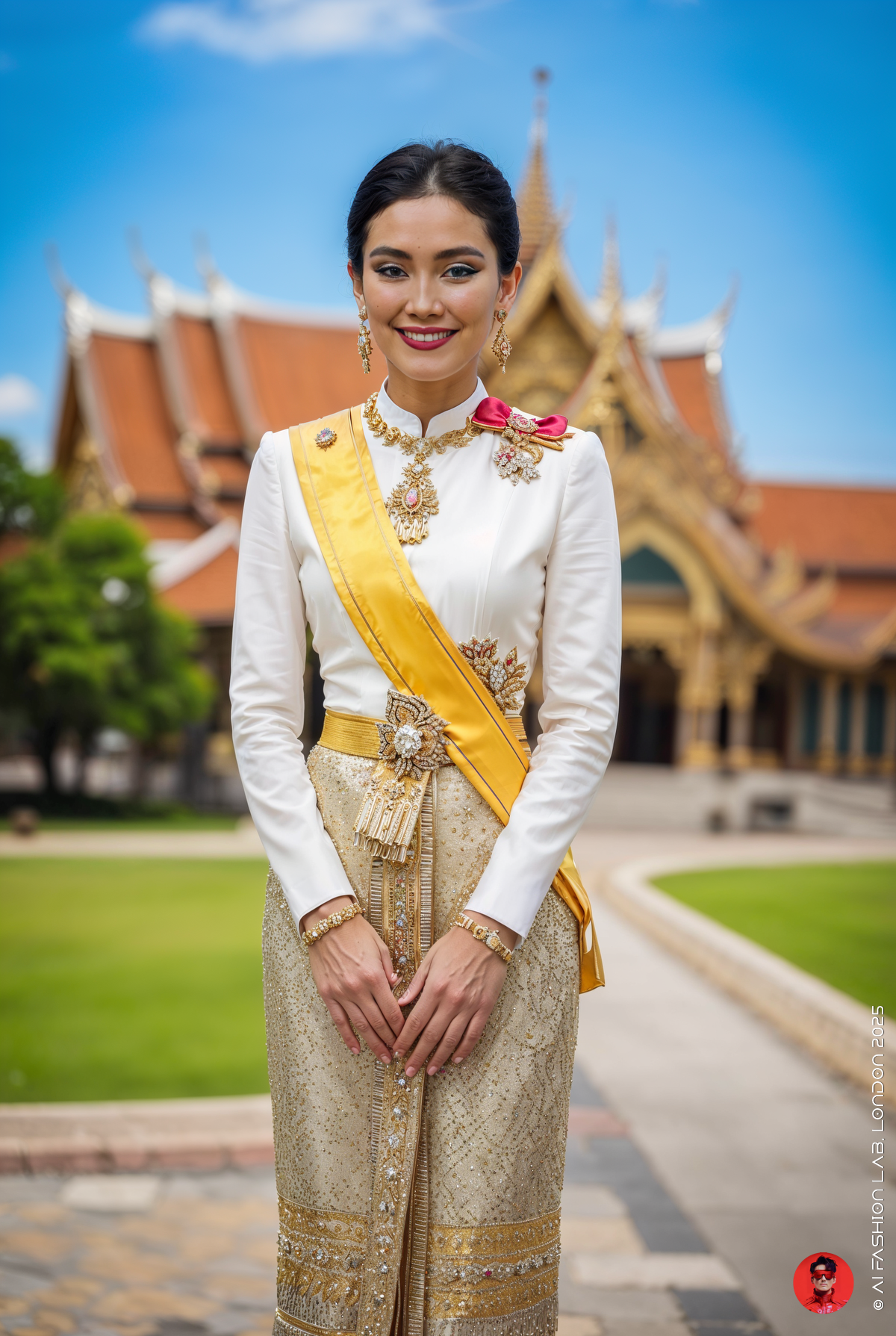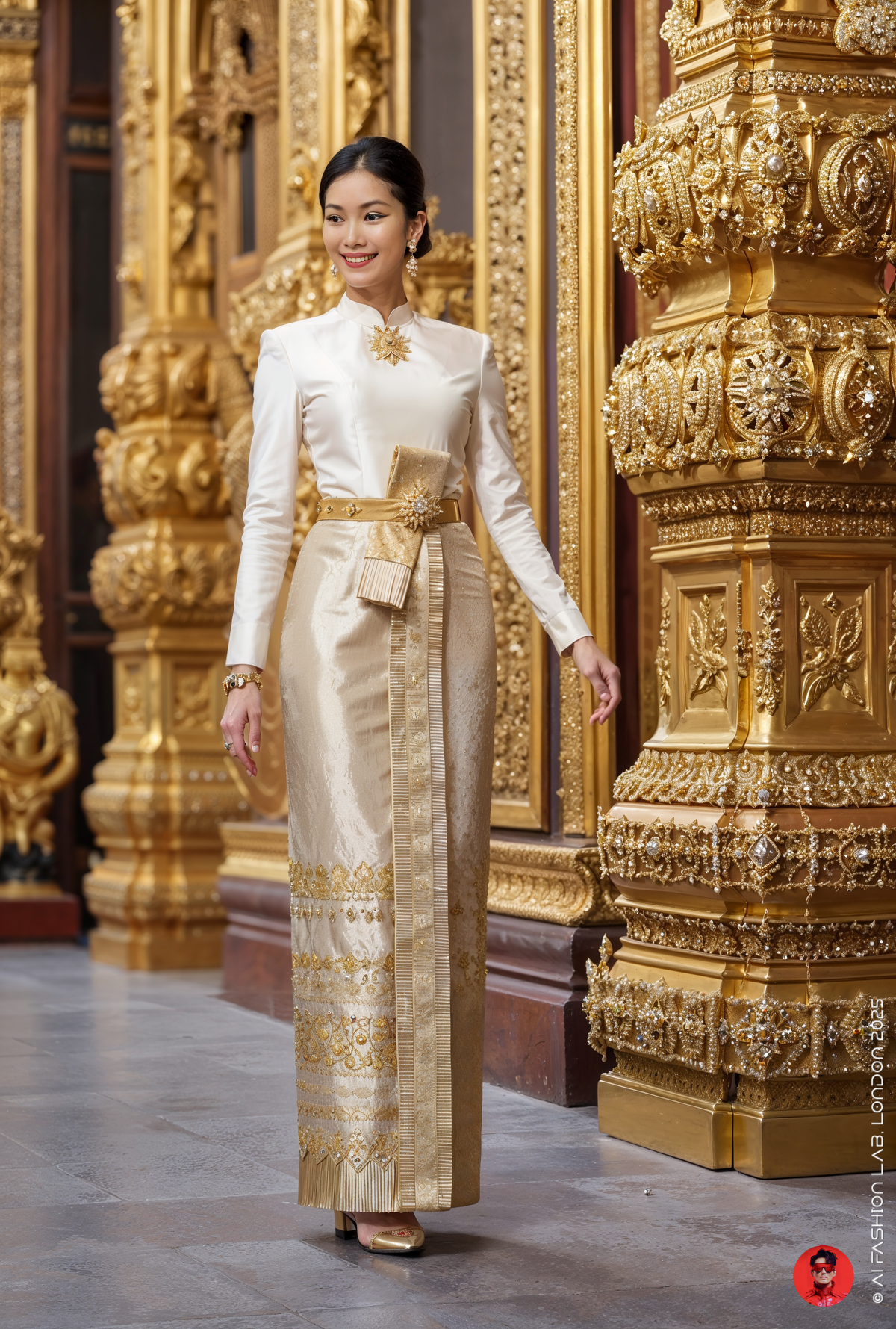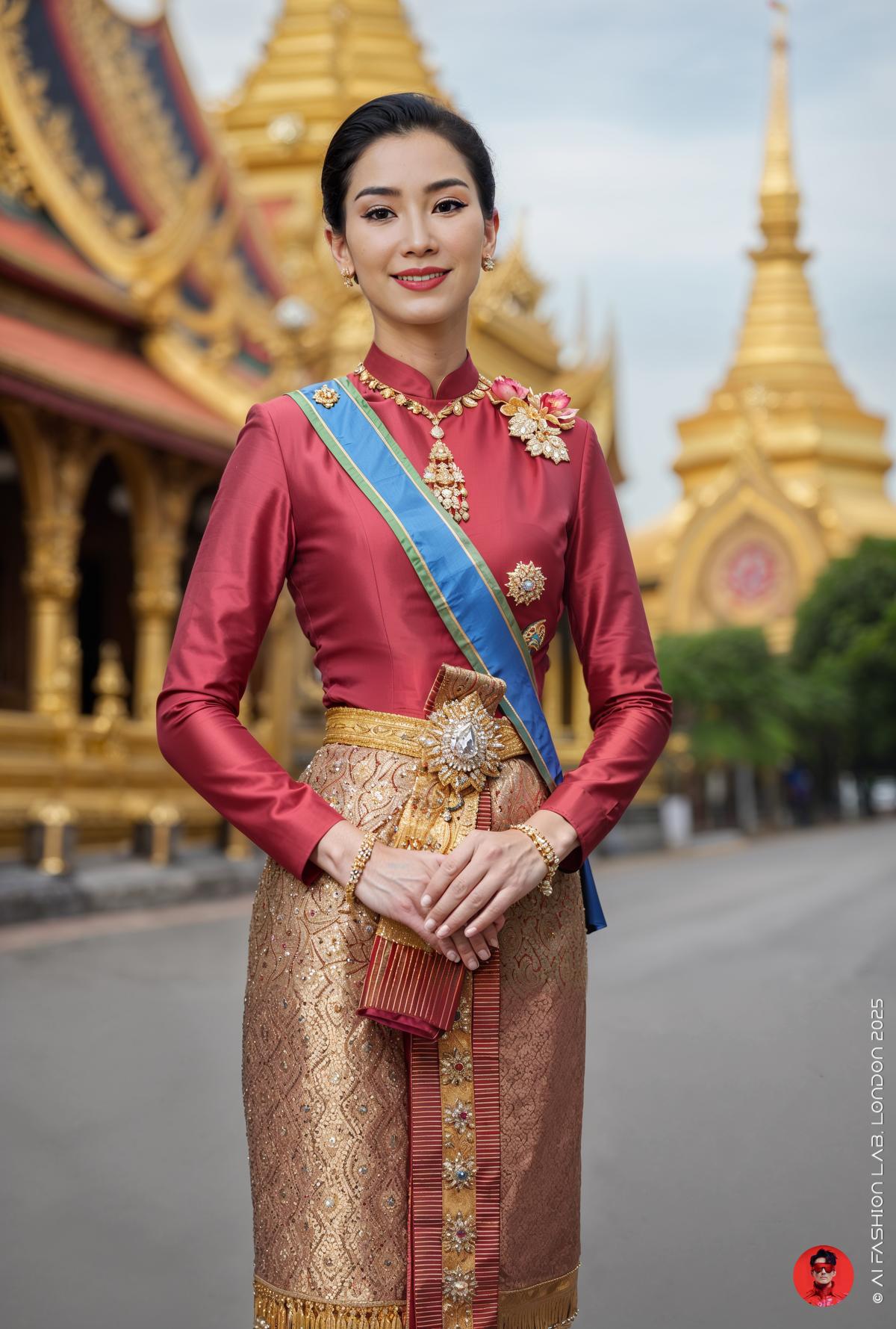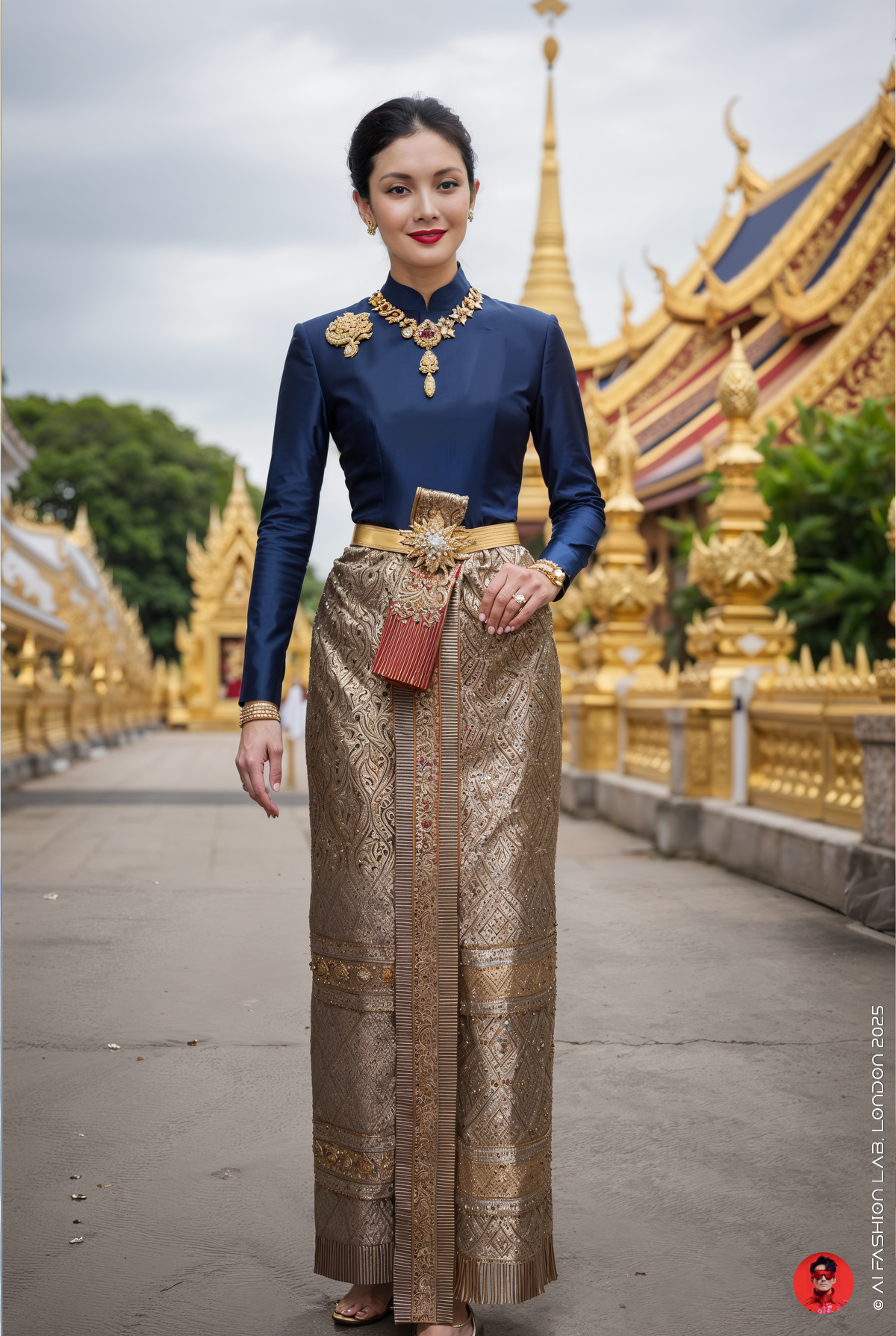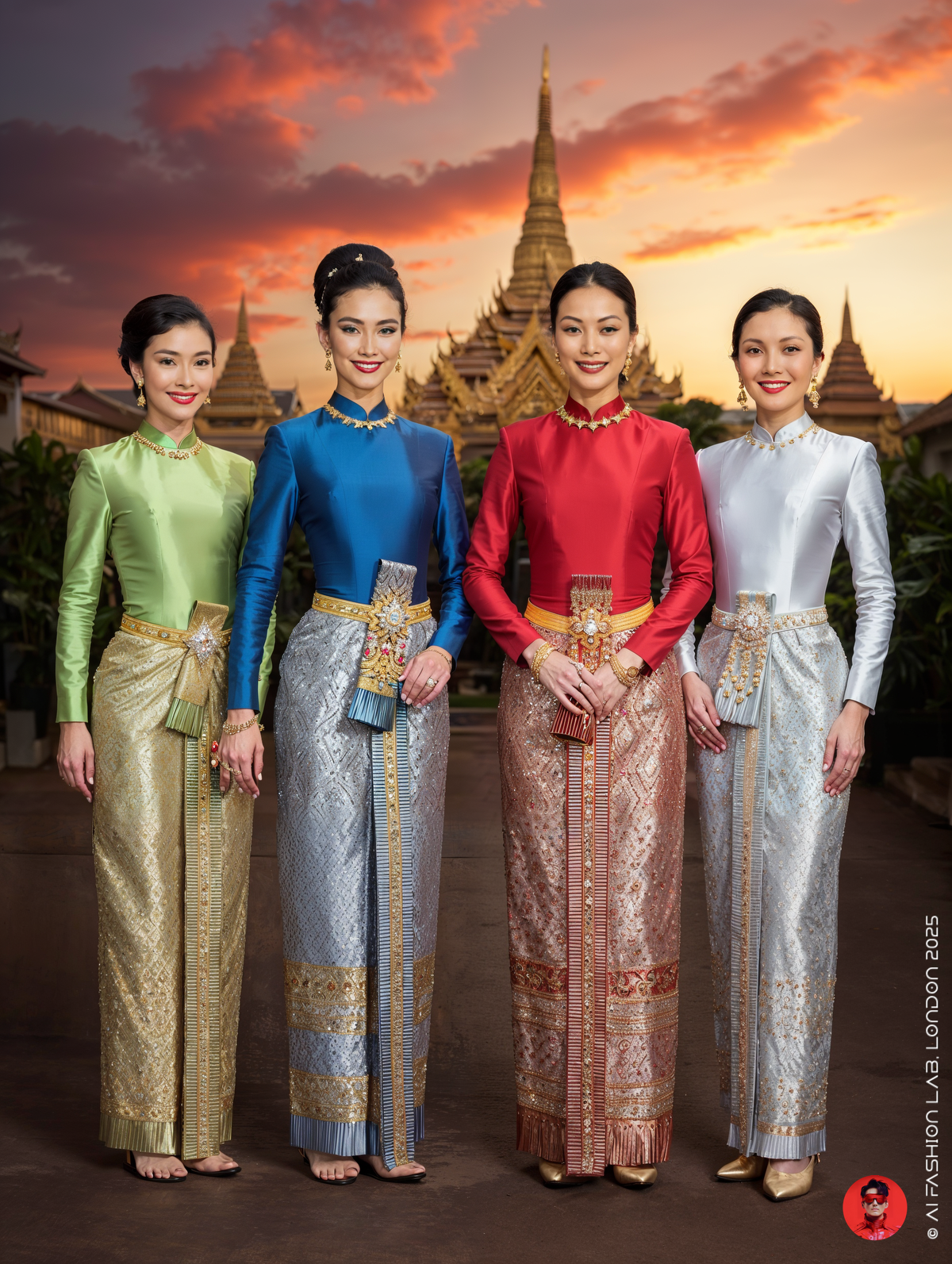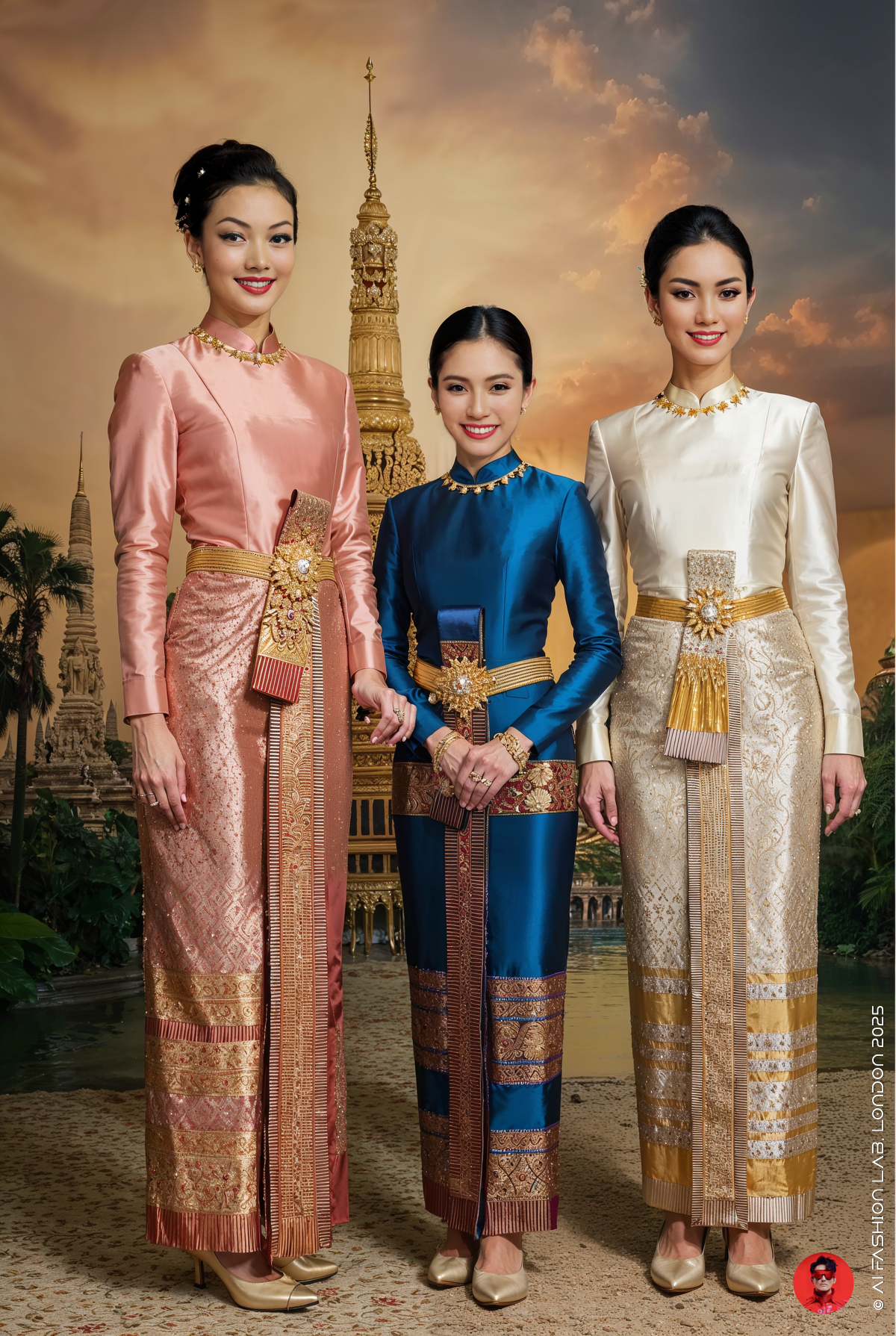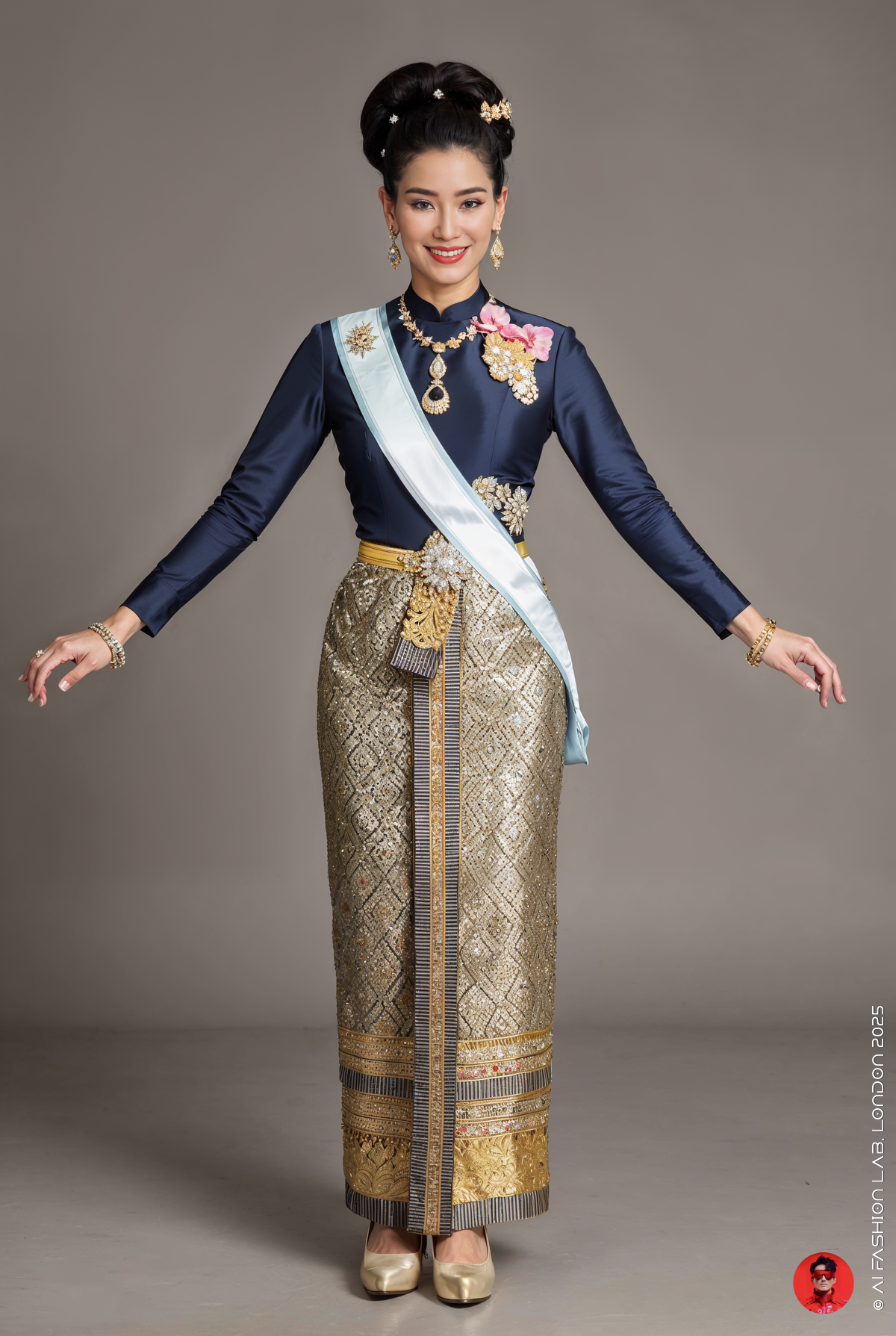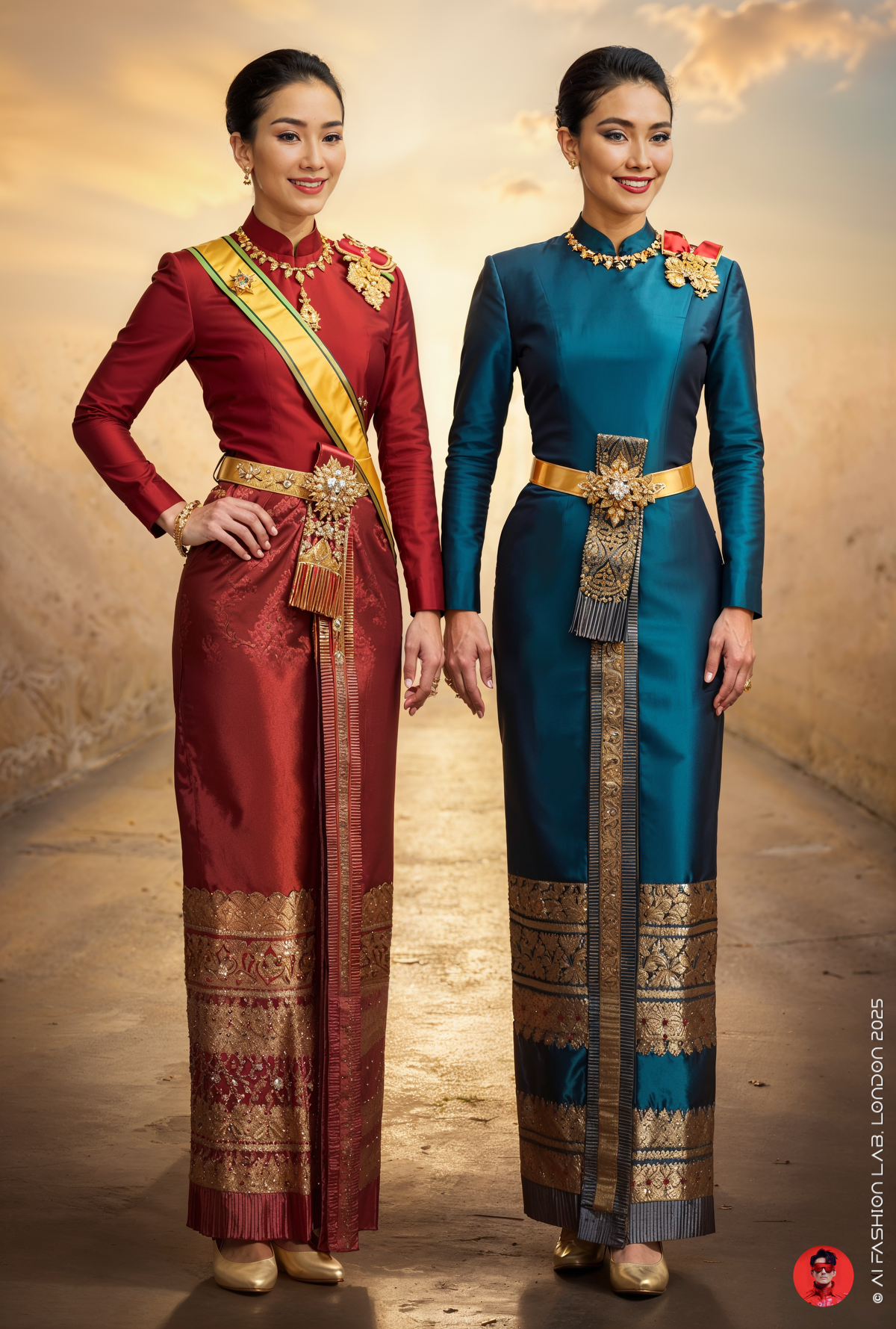ชุดไทยบรมพิมาน – ชุดไทยพระราชนิยม – เครื่องแต่งกายประจำชาติและความภาคภูมิใจในความเป็นไทย (๕ ใน ๘)
ชุดไทยบรมพิมาน – ชุดไทยพระราชนิยมแบบที่ ๕ จากทั้งหมด ๘ แบบ: เครื่องแต่งกายประจำชาติและความภาคภูมิใจในความเป็นไทย
ชุดไทยบรมพิมานเป็นหนึ่งในชุดไทยพระราชนิยมทั้งหมดแปดแบบ ที่สมเด็จพระนางเจ้าสิริกิติ์ พระบรมราชินีนาถ พระบรมราชชนนีพันปีหลวง ทรงพระกรุณาโปรดเกล้าฯ ให้รังสรรค์ขึ้น เพื่อเป็นต้นแบบของการแต่งกายที่สะท้อนเอกลักษณ์ความเป็นไทยอย่างงดงาม ทั้งยังกลมกลืนกับรสนิยมแบบสากลในยุคทศวรรษ 1960 อย่างมีระดับ
ชุดไทยบรมพิมานเป็นชุดพิธีสำหรับสวมใส่ในช่วงค่ำ ประกอบด้วยเสื้อแขนยาว คอกลมมีขอบตั้ง ตัวเสื้อและซิ่นอาจตัดเย็บติดกันหรือแยกชิ้นก็ได้ ซิ่นเป็นแบบจีบหน้านาง มีชายพก และยาวจรดข้อเท้า นิยมใช้ผ้าไหมยกดอกหรือยกดิ้นทอง ทั้งแบบมีเชิงหรือยกทั้งตัว พร้อมคาดเข็มขัดไทยบริเวณเอว ชุดนี้เหมาะสำหรับผู้มีรูปร่างสูงโปร่ง และใช้ในงานพิธีเต็มยศหรือครึ่งยศ อาทิ งานอุทยานสโมสร งานพระราชทานเลี้ยงอาหารค่ำ หรือพิธีสมรสในคืนที่มีอากาศเย็น โดยสามารถประดับเครื่องราชอิสริยาภรณ์และเครื่องประดับไทยโบราณตามความเหมาะสม
โดยรายละเอียด ชุดนี้ประกอบด้วยเสื้อทรงเข้ารูป แขนกระบอก คอตั้ง ติดคอ ผ่าหลัง และสามารถเย็บติดกับผ้านุ่งหรือแยกเป็นสองท่อนก็ได้ ส่วนผ้านุ่งเป็นผ้าซิ่นไหมยกดิ้นทอง ตัดแบบหน้านาง มีชายพก นิยมสวมใส่ในงานพิธีสำคัญ เช่น งานฉลองสมรส พิธีหลั่งน้ำสังข์ หรือพิธีเจริญพระพุทธมนต์
ในผลงาน AI Collection ชุดนี้ ผมได้ออกแบบชุดไทยบรมพิมานโดยเลือกใช้ผ้าไหมยกดิ้นทองตัดกับผ้าพื้นสีอ่อนหรือสีที่ตัดกัน เพื่อสร้างภาพลักษณ์ที่โดดเด่นเมื่อสวมสายสะพายเครื่องราชอิสริยาภรณ์ และประดับด้วยเครื่องประดับไทยโบราณ ช่วยเสริมให้ผู้สวมใส่ดูอ่อนหวาน สุภาพ สง่างาม และเหมาะสมกับงานพิธีราชการหรืองานเลี้ยงอย่างเป็นทางการ
ชุดไทยบรมพิมานจึงนับเป็นการผสมผสานอย่างลงตัวระหว่างความสง่างามของเครื่องแต่งกายไทยดั้งเดิม กับแนวคิดแบบร่วมสมัยในโลกสากลยุคใหม่ และยังเป็นหนึ่งในต้นแบบที่เหมาะสมยิ่งสำหรับการสร้างสรรค์ด้วยเทคโนโลยี AI ภายใต้แนวคิด “ความสง่างามแบบวินเทจสไตล์ไทย” ซึ่งทั้งร่วมสมัยและทรงคุณค่า
AI Collection ชุดนี้ได้รับแรงบันดาลใจจาก สมเด็จพระนางเจ้าสิริกิติ์ พระบรมราชินีนาถ พระบรมราชชนนีพันปีหลวง และ ชุดไทยพระราชนิยมทั้ง 8 แบบ ซึ่งทรงมีพระราชดำริจัดสร้างขึ้นระหว่างปี พ.ศ. 2503–2504 เพื่อให้สตรีไทยมีเครื่องแต่งกายที่สง่างาม สะท้อนเอกลักษณ์ของความเป็นไทย และเหมาะสมกับงานพิธีและโอกาสสำคัญต่าง ๆ
เพื่อเฉลิมพระเกียรติในพระราชดำริอันทรงคุณค่านี้ ผมจึงสร้างสรรค์ AI Collection ที่นำเสนอชุดไทยทั้ง 8 แบบผ่านมุมมองร่วมสมัย โดยผสมผสานกลิ่นอายแฟชั่นวินเทจแห่งยุค 1960s ซึ่งเป็นช่วงเวลาเดียวกับการกำเนิดของชุดเหล่านี้ ทั้งการจัดแสง ทรงผม และองค์ประกอบในภาพ ต่างได้รับการออกแบบอย่างประณีตเพื่อสะท้อนความงดงามของช่วงเวลาแห่งวัฒนธรรมไทยนี้อย่างสมบูรณ์
ในปีหน้า องค์การยูเนสโก (UNESCO) มีแนวโน้มจะขึ้นทะเบียน "ชุดไทยพระราชนิยม" เป็นมรดกภูมิปัญญาทางวัฒนธรรมของโลก โครงการนี้จึงมุ่งหวังที่จะเฉลิมฉลอง อนุรักษ์ และส่งต่อความภูมิใจในความเป็นไทยไปสู่คนรุ่นต่อไป
พระราชนิยมในการใช้ผ้าไทย: พระปณิธานของสมเด็จพระนางเจ้าฯ พระบรมราชินีนาถ
สมเด็จพระนางเจ้าฯ พระบรมราชินีนาถ ทรงมีพระราชนิยมในการใช้ ผ้าไทย มาตั้งแต่ยังทรงพระเยาว์ เมื่อครั้งสมเด็จพระเจ้าอยู่หัวมีพระราชดำริจะทรงประกาศหมั้น นักหนังสือพิมพ์ต่างประเทศได้ขอสัมภาษณ์พระองค์ ซึ่งพระองค์ทรงตอบอย่างชัดเจนว่า จะสนับสนุนและส่งเสริมการแต่งกายแบบไทย
ในโอกาสนั้น พระองค์ในฐานะ “พระคู่หมั้น” ทรงเลือกใช้ ผ้าไหมไทย และ ซิ่นไทย สำหรับชุดต่าง ๆ รวมถึง ฉลองพระองค์ในพระราชพิธีอภิเษกสมรส ก็ทรงใช้ผ้าไทยอย่างภาคภูมิ ภายหลังจากพระราชพิธีดังกล่าว พระองค์ทรงยึดมั่นในพระราชปณิธาน และทรงพระกรุณาโปรดให้สร้าง “เครื่องแต่งกายแบบไทยตามพระราชนิยม” ขึ้น จนกลายเป็น เครื่องแต่งกายประจำชาติของสตรีไทย มาจนถึงปัจจุบัน
ในสมัยที่เสด็จฯ เยือนประเทศเพื่อนบ้านเป็นครั้งแรก ยังไม่มีการกำหนดชุดไทยตามแบบพระราชนิยม พระองค์จึงทรงริเริ่มออกแบบฉลองพระองค์โดยใช้ ผ้าไหมไทย ผ้ายก และผ้าพื้นถิ่นไทย ต่าง ๆ มาตัดเย็บและประดิษฐ์ตกแต่ง เพื่อให้สื่อถึงอัตลักษณ์ของความเป็นไทย โดยทรงเจริญรอยตามสมเด็จพระพันปีหลวง สมเด็จพระศรีพัชรินทรา บรมราชินีนาถ
ชุดไทยพระราชนิยม
“ชุดไทยพระราชนิยม” หมายถึง ชุดแต่งกายประจำชาติของสตรีไทยที่ใช้ในงานพิธี งานมงคลสมรส และโอกาสสำคัญต่าง ๆ ชุดเหล่านี้มีลักษณะเฉพาะทางด้านรูปแบบ วัสดุ และการตกแต่ง โดยนิยมใช้ผ้าไหม ผ้าฝ้าย หรือผ้าใยประดิษฐ์ เช่น ผ้าพื้น ผ้าลายดอก ผ้าลายริ้ว ผ้ายกดิ้นเงิน ดิ้นทอง หรือผ้ายกดอกทั้งผืน พร้อมตกแต่งด้วยซิป ตะขอ หรือกระดุมที่หุ้มด้วยผ้า และอาจปักมุก เลื่อม หรือใช้ลูกปัดตกแต่งเพื่อเพิ่มความสง่างาม
ประเภทผ้าที่นิยมใช้ เช่น:
ผ้าไหม: ทอจากเส้นด้ายที่ได้จากใยไหม
ผ้าฝ้าย: ทอจากเส้นด้ายฝ้ายธรรมชาติ
ผ้าใยประดิษฐ์: ผ้าใยสังเคราะห์ เช่น โพลีเอสเตอร์ เรยอน เจอร์ซีย์ หรือโทเร
ชุดไทยพระราชนิยมทั้ง 8 แบบ ได้แก่
ชุดไทยเรือนต้น – เรียบง่าย เหมาะสำหรับงานไม่เป็นทางการหรือสวมใส่ในชีวิตประจำวัน
ชุดไทยจิตรลดา – สุภาพ เหมาะสำหรับงานพิธีการเล็กน้อยหรือรับรองแขก
ชุดไทยอมรินทร์ – งดงาม เหมาะกับงานราตรีหรืองานพิธีสำคัญ
ชุดไทยบรมพิมาน – ผ้าไหมลายสวย ใช้ในงานพิธีการและงานทางการ
ชุดไทยจักรี – หรูหรา สง่างาม เหมาะกับงานพิธีระดับสูง
ชุดไทยดุสิต – ใช้ผ้าไหมลวดลาย ปักลายวิจิตร สำหรับงานราตรีหรืองานฉลอง
ชุดไทยศิวาลัย – หรูหรา เน้นเครื่องประดับ ใช้ในงานพิธีสำคัญ
ชุดไทยจักรพรรดิ์ – สง่างามที่สุด ใช้ในงานพิธีใหญ่ระดับราชสำนัก
Chut Thai Boromphiman (ชุดไทยบรมพิมาน) – The Fifth of the Eight Official Royal Thai Costumes: A National Attire and Symbol of Thai Pride
Chut Thai Boromphiman (ชุดไทยบรมพิมาน) is one of the eight official royal Thai costumes graciously commissioned by Her Majesty Queen Sirikit the Queen Mother. It was designed to represent the unique identity of Thai culture while harmonising elegantly with international fashion sensibilities of the 1960s.
This ensemble is intended for evening ceremonial wear. It features a long-sleeved blouse with a round neckline and a standing collar. The blouse and pha sin (Thai tube skirt) may be sewn together as one piece or worn separately. The skirt follows the traditional na nang style, with front pleats, a side train (chai pok), and is ankle-length. Typically made from brocade silk or gold-threaded silk, the fabric may have a patterned hem or be fully brocaded. A traditional Thai belt is worn around the waist. This costume flatters those with a tall and slender figure and is appropriate for formal and semi-formal occasions, such as Uthayan Samosorn functions, state banquets, and evening wedding ceremonies. It may also be worn with royal decorations and elegant traditional Thai jewellery.
In detail, the blouse is form-fitting with straight sleeves and a standing collar, and it opens at the back. It may be sewn to the skirt or made as a separate piece. The pha sin is crafted from gold-threaded silk brocade in the na nang style with a side train. This costume is typically worn for formal royal ceremonies, wedding celebrations, water-pouring rituals, or Buddhist prayer ceremonies.
In this AI Collection, I have designed the Chut Thai Boromphiman using gold-threaded silk brocade paired with a soft-coloured or contrasting plain silk. The costume is complemented by the royal sash and exquisite traditional Thai accessories, creating a look that is graceful, refined, and dignified—ideal for formal occasions such as royal receptions or evening state ceremonies, weddings, and other auspicious events.
Chut Thai Boromphiman represents a perfect blend of the timeless elegance of traditional Thai dress and the refined influence of modern international fashion. It is an ideal model for AI-based visual creation under the concept of "Vintage Thai Elegance", combining contemporary relevance with deep cultural value.
This AI Collection draws inspiration from Her Majesty Queen Sirikit The Queen Mother and the full series of eight Chut Thai Phra Ratcha Niyom (ชุดไทยพระราชนิยม), which were developed under her royal initiative between 1960 and 1961. The goal was to create refined and graceful national attire for Thai women—garments that reflect Thai cultural identity and are appropriate for ceremonial functions and state occasions.
To honour this visionary royal initiative, I have created an AI Collection that reimagines all eight styles through a contemporary perspective. Each image is infused with the charm of 1960s vintage fashion—the era in which these national dresses first emerged. Lighting, hairstyle, and composition have all been meticulously crafted to convey the beauty of this cultural moment in Thai history.
Royal Patronage of Thai Textiles: Her Majesty’s Lifelong Commitment
Her Majesty Queen Sirikit The Queen Mother has embraced Thai textiles since her youth. When His Majesty King Bhumibol Adulyadej (Rama IX) intended to announce their engagement, foreign journalists interviewed Her Majesty, who expressed her firm commitment to promoting Thai dress.
At the time, as the royal fiancée, she chose to wear Thai silk and traditional Thai sinh in various ensembles. Notably, she wore Thai fabrics with pride during the Royal Wedding Ceremony. After the ceremony, Her Majesty continued to champion Thai textiles, graciously initiating the creation of the Chut Thai Phra Ratcha Niyom (ชุดไทยพระราชนิยม)—a series of formal national dresses for Thai women, now recognised as part of Thailand’s cultural identity.
During her first state visits to neighbouring countries, when no official Thai national dress had yet been established, Her Majesty began designing her formal attire using Thai silk, brocade, and regional Thai textiles. These designs reflected the essence of Thai identity and followed in the footsteps of Queen Saovabha Phongsri (Queen Sri Bajarindra), consort of King Chulalongkorn (Rama V), who had once served as Queen Regent.
Chut Thai Phra Ratcha Niyom (ชุดไทยพระราชนิยม)
Chut Thai Phra Ratcha Niyom refers to the formalised series of Thai national dresses for women, used in ceremonies, weddings, and official events. These garments are characterised by specific patterns, fabrics, and decorative details. Common materials include silk, cotton, and synthetic fibres, in plain colours, floral prints, stripes, or intricately woven patterns using metallic threads. Decorations may include fabric-covered buttons, zippers, or hooks, and sometimes delicate embellishments such as pearls, sequins, or beadwork.
Common fabrics used:
Thai silk – woven from natural silk fibres
Cotton – made from natural cotton threads
Synthetic fibres – such as polyester, rayon, jersey, or Toray
The Eight Styles of Chut Thai Phra Ratcha Niyom (ชุดไทยพระราชนิยม):
Chut Thai Ruean Ton (ชุดไทยเรือนต้น) – Simple, ideal for informal or everyday wear
Chut Thai Chitralada (ชุดไทยจิตรลดา) – Modest, suitable for semi-formal events or diplomatic receptions
Chut Thai Amarin (ชุดไทยอมรินทร์) – Elegant, appropriate for evening functions or formal ceremonies
Chut Thai Boromphiman (ชุดไทยบรมพิมาน) – Refined, typically made of patterned silk for ceremonial use
Chut Thai Chakri (ชุดไทยจักรี) – Luxurious and stately, ideal for high-level royal functions
Chut Thai Dusit (ชุดไทยดุสิต) – Decorated with intricate patterns, suitable for gala dinners or celebrations
Chut Thai Siwalai (ชุดไทยศิวาลัย) – Ornate and jewel-accented, designed for important royal ceremonies
Chut Thai Chakkraphat (ชุดไทยจักรพรรดิ์) – The most majestic, reserved for grand palace occasions
#aifashionlab #AI #aiartist #aiart #aifashion #aifashiondesign #aifashionstyling #aifashiondesigner #fashion #fashionhistory #historyoffashion #fashionstyling #fashionphotography #digitalfashion #digitalfashiondesign #digitalcostumedesign #digitaldesign #digitalaiart #ThaiFashionHistory #ThaiFashionAI














